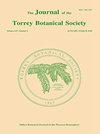阿巴拉契亚南部地区红、黑樱桃(Aronia arbutifolia和a . melanocarpa)的分布和结果
IF 0.8
4区 生物学
Q4 PLANT SCIENCES
引用次数: 8
摘要
每个区域),并记录每个子茎上的果粒数量。三分之二的蔓越莓生长在早期演替栖息地。在早期演替区,黑颈莓在所有颈莓茎中占72%,在森林区占79%。在森林地区几乎没有观察到树墩,也没有红樱桃果实。在早期演代区,两种树的结果比例几乎相等(红颈莓占8%,黑颈莓占10%)。然而,在整个研究中,红樱桃每根茎产生的果粒明显多于黑樱桃,比黑樱桃多20%本文章由计算机程序翻译,如有差异,请以英文原文为准。
The distribution and fruiting of red and black chokeberry (Aronia arbutifolia and A. melanocarpa) in a southern Appalachian fen1
each area of the fen), and recorded the number of pomes on each fruiting stem. Two-thirds of all chokeberries occurred in the early successional habitat. Black chokeberry dominated both areas, comprising 72% of all chokeberry stems in the early successional area, and 79% in the forested area. Few pomes were observed in the forested area, and no red chokeberries fruited there. In the early successsional area, nearly equal percentages of each species produced fruit (8% of red chokeberries, and 10% of black chokeberries). However, red chokeberry produced significantly more pomes per stem, as well as 20% more pomes than black chokeberry, across the
求助全文
通过发布文献求助,成功后即可免费获取论文全文。
去求助
来源期刊
CiteScore
0.70
自引率
0.00%
发文量
16
审稿时长
>12 weeks
期刊介绍:
The Journal of the Torrey Botanical Society (until 1997 the Bulletin of the Torrey Botanical Club), the oldest botanical journal in the Americas, has as its primary goal the dissemination of scientific knowledge about plants (including thallopyhtes and fungi). It publishes basic research in all areas of plant biology, except horticulture, with an emphasis on research done in, and about plants of, the Western Hemisphere.

 求助内容:
求助内容: 应助结果提醒方式:
应助结果提醒方式:


